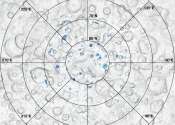Cassini shapes first global topographic map of Titan
(Phys.org) —Scientists have created the first global topographic map of Saturn's moon Titan, giving researchers a valuable tool for learning more about one of the most Earth-like and interesting worlds in the solar system. ...








